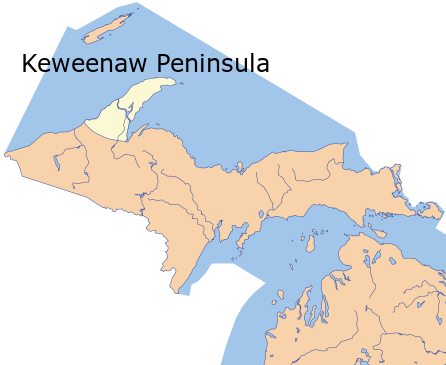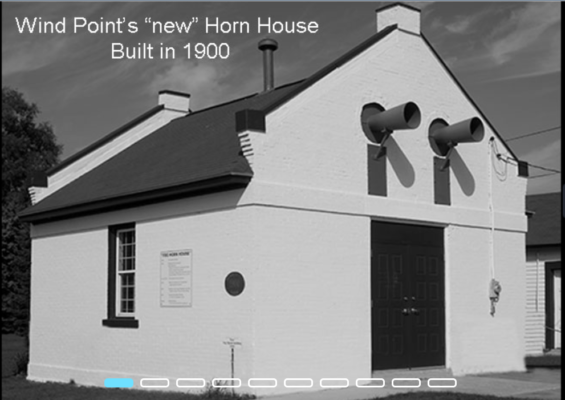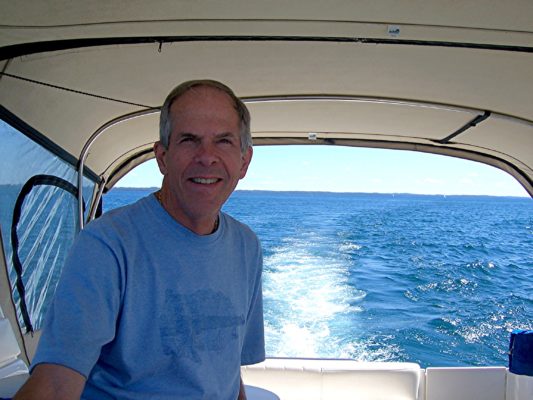From time to time, ISEA will share Great Lakes experiences from guest bloggers. In this blog, Bill Betts shares his adventure at the tip of the Keweenaw Peninsula. Email marketing@schoolship.org if you would like to submit a Great Lakes experience to be featured.
Journey with me back to a day in my life about 60 years ago. I was a high school senior on summer break, feeling my oats, and enjoying every minute of life with my family as we drove north for a glorious August week at my Uncle Bob’s beautiful cabin on the ancient granite and pine tree-studded shore of Lake Superior.

The cabin is a about half a mile west of Eagle Harbor on the Keweenaw Peninsula. If you don’t know, Keweenaw is Michigan’s northernmost point of land extending about 70 miles from the state’s Upper Peninsula out into Lake Superior. It’s a magical place for nature-lovers, hikers, boaters, connoisseurs of thimble berries, and historians interested in Michigan’s bygone era of lucrative copper mining. I’ll never forget looking out across the lake at night and seeing the lights of up to a dozen giant freighters loaded with coal, iron ore, and grain as they sailed from Duluth to southern Great Lakes ports. They looked like a sparkling string of pearls stretching 180 degrees across the dark horizon.
On this trip we towed our 12-foot open boat with its ten-horse outboard engine behind the car, and I looked forward to cruising the Lake Superior shoreline near the cabin on the water. I explored it thoroughly on foot during a half-dozen previous summer visits. My father and I spent many of my early years boating together. By now, he trusted me to handle our small boat safely all by myself.
In those days GPS navigation satellites had not yet been launched to aid ships on the Great Lakes. There were some radio beacon aids, but, mostly, sailors navigated using their ship’s direction, speed, and time to determine their approximate location on detailed maritime charts. And for centuries they were also aided by landmarks and lighthouses. When fog blinded them, they slowed down and listened for whistles on other ships, bells on floating buoys, and shoreline foghorns to help them avoid danger.

Eagle Harbor had a lighthouse and a foghorn — two horns, actually — mounted side-by-side on top of a building next to the lighthouse and aimed out across the water. From my uncle’s cabin you could hear them in the distance when fog rolled in. Foghorn sound is not like an airhorn at a football game. Instead, it’s a long moan or low-pitched growl that conjures up images from movies of lonely people looking out to sea from a fog-shrouded shore.
Foghorns are very loud, powerful signals to those in their path. Originally powered by steam, by the 1800s they were converted to compressed air generated by diesel engines. At Eagle Harbor in those days, they used Type F diaphone foghorns that could be heard on ships up to six miles offshore.
One sunny day I decided to fulfill a dream, so I donned my PFD and began to drive my little boat from my uncle’s cabin, along the rocky shore, and into the sanctuary of Eagle Harbor. There was some mist along the shore, but the air was quite clear, the sky was blue, and the water was smooth. What I did not know, was that the Coast Guard observed some thick fog a few miles offshore, and they decided to start up the foghorns. It happened when I was happily skimming along the water – right in front of them.
Did I mention that fog horns are loud? For reference, hearing loss can happen when sustained sound is above 90 decibels, ear pain happens at about 125 decibels, the sound of a full-throttle jet engine a hundred feet away from you is about 140 decibels. Well, the modern foghorn produces 142 decibels of sound, and there were two of them pointed at me at that moment.
The blast was about six seconds long, and it felt like an eternity. It wasn’t just sound. I felt every low-frequency pulse hit every part of my body like a physical punch. My hair vibrated. Fillings rattled in my teeth. My teeth rattled in their sockets. Every internal organ rattled against all the others. I think that if I had kidney stones at the time, they would have been reduced to powder. When the blast stopped, I checked my ears to see if blood or brains were running out of them.

I was shaking as I motored around the rocky edge of the channel entrance and onward into Eagle Harbor. I beached my boat on the sandy public beach in town and went to Rudy’s General Store for one of his delicious ice cream cones to settle my nerves. All the while I was hoping the distant fog would lift and the horns would stop, but no, they kept going. I had to get back to the cabin soon or my parents would worry.
I came up with a defensive strategy and motored to the mouth of the harbor and paused off to the side and a little behind the horns where the sound of the blasts was tolerable. I counted seconds between each of the blasts. 78 seemed to be the regular interval.
After the next blast ended, I cranked the throttle wide open and headed for the cabin as fast as my little boat would go. When I reached the count of 78, to my horror, I was dead in front of the horns again. I made it back to the cabin but never again attempted driving my boat back into Eagle Harbor.
Today the Eagle Harbor foghorn building is part of the Keewenaw County Historical Society’s Maritime Museum. The Eagle Harbor fog horns have been moved to a museum at Sault Ste. Marie. I live in Ann Arbor, but the sound of those foghorns still echoes in my head.
Bill Betts grew up in Detroit. Some of his greatest childhood memories are about operating small boats with his father on Michigan’s inland lakes. His personal recreational boats have progressively grown larger, and he has – along with his wife, Carole, and son, Brian – piloted boats for hundreds of miles on Lakes Michigan, Huron, and St. Clair. The homeport of his last, 30-foot personal cruiser was the Suttons Bay Marina, within sight of the dock that the Schoolship Inland Seas calls home. He has operated, worked on, been a boat passenger or stood on the shore of every Great Lake and the St. Lawrence River. While in college, Bill worked summer jobs on the Bob-Lo boat SS Ste. Claire and the National Steel freighter SS Thomas E. Millsop in the 1960s. Bill is a former broadcast journalist, and he retired from General Motors after years there as a global communications and media relations manager.